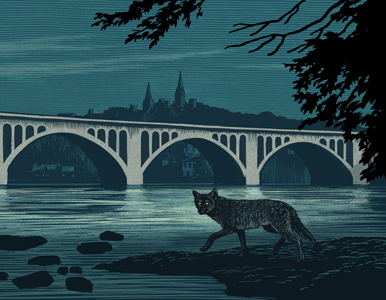
At 10:16 p.m. on April 28, 2019, a rustle in the woods of Rock Creek Park triggered a remote infrared camera attached to the base of a nearby tree. And with that, Lindsay Powers captured the first great find of her thesis project.
The environmental science graduate student reviewed her camera’s haul of still images and locked her eyes on the glowing pair staring back at her. Near the edge of the black-and-white frame stood a furry, four-legged creature making its nightly rounds.
Powers, CAS/MS ’20, excitedly scribbled a single word in her notebook: coyote.
Native to western North America, coyotes have been expanding eastward since the early 1900s. As humans have targeted their natural predators, including wolves and bobcats, many coyotes have adapted to urban areas, developing more nocturnal tendencies and feasting on food sources that abound near humans, like rodents.
They only recently moved to the Mid-Atlantic, however, with the first coyote spotted around Rock Creek Park in 2004.
Powers has spent the last year researching DC’s newest predators to learn more about their habits. In March 2019, she began setting up motion-sensor cameras along man- and animal-made trails in the northern swath of the 1,700-acre park. She also collected coyote scat samples and, later that summer, began conducting howl surveys to elicit vocal responses.
As of December, Powers was hearing crickets—not coyotes. “They’re so smart,” she says. “We’re pretty confident they can hear us, but they’re just not responding.” She had, however, confirmed several sightings and gathered 31 scat samples for diet analysis.
“Little research has been done on coyotes in DC, so there is an opportunity here to answer important ecology questions,” she says. “We can learn more about what they’re eating, how they’re moving through the space, and, hopefully, how to monitor and identify them, especially as their population grows.”
Data gathered by Powers will benefit the National Park Service; the District Coyote Project, an educational website that collects citizen-reported sightings, founded by Virginia Tech professor Megan Draheim, a member of Powers’ thesis committee; and Washingtonians who will soon encounter more of the menacing mammals.
“You can educate people who might not even know that there are coyotes [on how to coexist] before you have conflicts,” says AU biology professor Christopher Tudge, Powers’ thesis advisor. “You can be proactive and not wait for those first couple of newspaper articles about, ‘This coyote ate my dog.’”
Heed their howl: Coyotes are our new neighbors, and they’re here to stay.